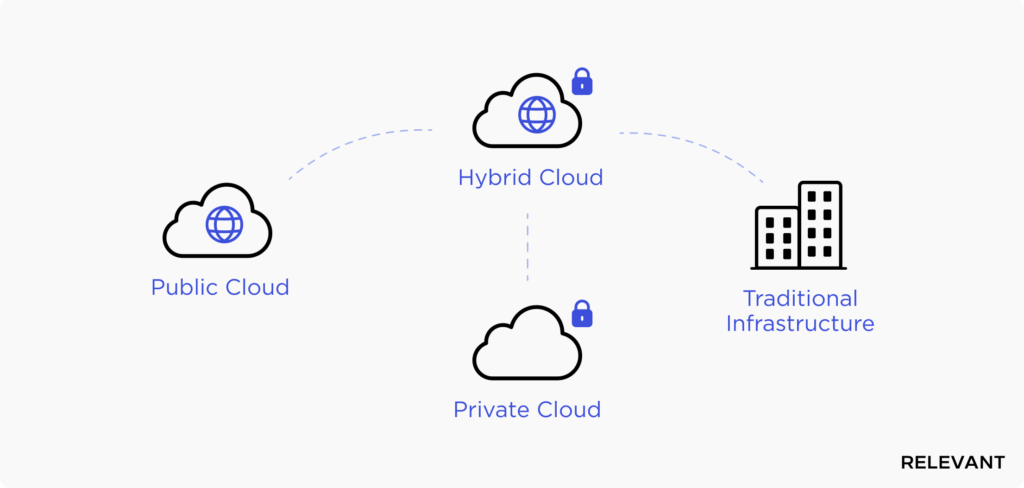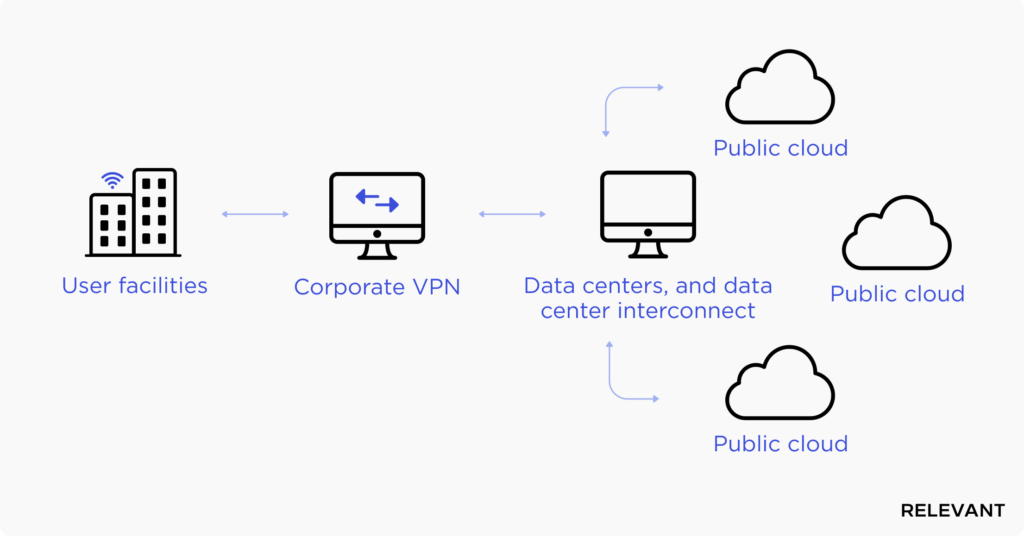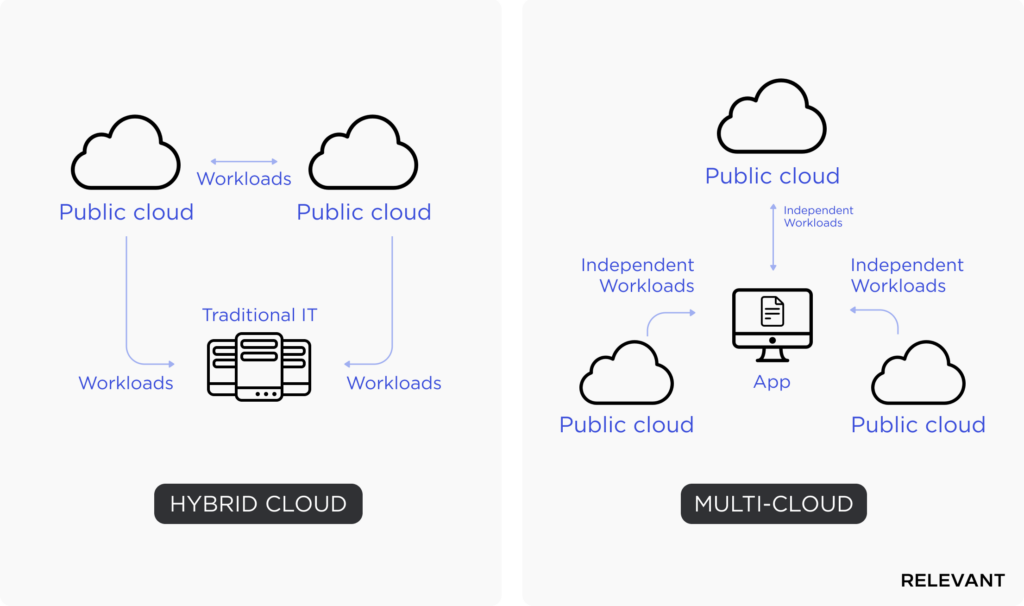Hybrid Cloud Service: Everything You Should Know
Updated: June 4, 2025
Cloud computing is evolving to offer new ways businesses run. One of them is a hybrid cloud. Flexera’s 2022 report states that 80% of enterprises embrace a hybrid cloud strategy. The acceptance rate continues to rise – with 98% of companies planning to use this environment. Thus, the hybrid cloud market is predicted to reach $128 billion by 2025.
Why is the hybrid cloud model so popular? Because it offers the advantages of both concepts – the power and cost-effectiveness of a public cloud coupled with the security and predictability of the private infrastructure. This way, you become a cloud-enabled company without giving up on-premise data centers.

We provide companies with senior tech talent and product development expertise to build world-class software. Let's talk about how we can help you.
Contact usAs interest and investment in hybrid cloud solutions grow, your hybrid cloud awareness should keep up. Review this overview guide to understand the hybrid cloud approach and determine if hybrid cloud services are right for your company and your customers.

Table of Contents
What is a hybrid cloud?
A hybrid cloud definition partly clarifies things: “hybrid” usually means something that consists of different elements or components from different sources. Accordingly, a hybrid cloud is a computing model that converges one or more environments through a network connection.
A hybrid cloud can combine on-premises and cloud service provider resources or cloud platforms and services without a local component. Extended, it can span multiple heterogeneous on-premises infrastructures such as private cloud, servers, containers, and virtualized infrastructure, like public clouds from various cloud providers.
These diverse cloud components are not in silos but well-connected and integrated to deliver seamless processing power. Proper hybrid cloud integration makes managing and monitoring the entire cloud infrastructure easier and ensures seamless data and application portability.

How does the hybrid cloud work?
Each hybrid cloud environment contains the following components:
- Public cloud services. It is an IT model where infrastructure and services are managed by a third-party provider and shared via the public Internet. Such offerings are available as Infrastructure as a Service (IaaS), Platform as a Service (PaaS), or Software as a Service (Saas) with a monthly or per-use fee. Any hybrid cloud has at least one public cloud component.
- Private cloud or/and on-premise servers. These dedicated systems serve the same purpose as public clouds but only for selected users instead of the general public and often have a higher price than public clouds. They can be set up internally or used as a service from a third-party vendor. Hybrid cloud architecture typically has one private cloud or on-premise setup.
- Integrators. The concept of a hybrid cloud hinges on how well existing components are connected and set up for upcoming additions. This is usually implemented by using virtual private networks (VPNs), application programming interfaces (APIs), and wide area networks (WANs). A hybrid cloud is just as efficient as its integration mechanism. Each approach must be secure to prevent data loss, compromise, or theft.
- Data fabric. It is a software-led approach that provides a unified architecture that runs on top of the diverse technologies in a hybrid environment. It allows organizations to manage the data that flows between each segment.
- Unified management tools. This set of tools for hybrid cloud management works as a central access point to all the environments on which the technology runs. This includes bridging various features, login systems, and data manipulations. These tools typically include:
a. Centralized IAM across environments
b. Integrated network with segmentation
c. Resource management
d. Monitoring solutions
e. Data governance tools
These components are the most common way to build a hybrid cloud infrastructure. It implies multiple iterations of middleware to connect various clouds in the system. Vendors like Google or AWS offer preconfigured VPNs for easy integration with other clouds. Creating a hybrid network is best suited when organizations have legacy systems and opt for the cloud for newer apps.
An alternative way to build a hybrid cloud is developing and deploying small, portable, loosely coupled apps that run in any environment. That means that underlying hardware and operating systems are made uniform instead of focusing on connecting various environments. It eliminates the need for complex APIs to connect. The app’s fluidity makes it easier to move across the components.
This hybrid cloud method relies largely on microservices and enables seamless integration between the development and DevOps teams. That is a more advanced approach to the hybrid cloud concept and is the best method to build an infrastructure from scratch.
A physical view of an optimal hybrid cloud network

Hybrid cloud benefits
The benefits of hybrid cloud solutions seem clear, given that hybrid cloud combines the better elements of private and public clouds. We list the most significant of them:
Lower IT spending & operational costs
A hybrid cloud offers a cost-effective way to scale your operations to cope with surges in demand and accommodate long-term growth. When demand spikes, a hybrid cloud can avoid the huge capital costs of expanding your infrastructure and pay only for the cloud resources you use. Leveraging the cloud’s pay-for-what-you-use cost models shift expenditures from costly CapEx to OpEx.
Better performance and reduced latency
The hybrid cloud model provides business continuity and mitigates potential downtime and resulting costs. It helps you back up (by replicating business-critical data to the cloud) and assures scalability in the event of a massive spike in demand. As computing demands fluctuate, the company is safe from overburdening its private servers (which could cause slow services or downtime). The cloud will scale to absorb the need. The above factors also apply to latency; through the hybrid cloud model, you reduce the time it takes for data to move.
Enhanced regulatory compliance and security
Centralized hybrid cloud management makes it easier to implement strong technical security measures such as encryption, access control, automation, orchestration, and endpoint security to manage risks effectively. The hybrid environment lets security teams standardize redundant cloud storage, an important aspect of disaster recovery and data insurance.
Moreover, the hybrid cloud helps you store locally gathered customer data in public cloud regions that comply with data localization requirements and protect customers’ privacy as required by law.
Greater infrastructure efficiency
A hybrid cloud is great for making quick changes as needed, without any shutdowns or even slowdowns. With the right cloud provider, data migration between environments, VMs, or containers is done with a single button, meaning IT teams are more efficient, and users have the best, most consistent experience.
Increased agility and scalability
A hybrid cloud delivers options for when and where to deploy workloads and data, which speeds up IT response to changing needs. Using familiar tools and processes, you can leverage public cloud providers’ instant flexibility and near-real-time scaling.
Overall business acceleration
A hybrid cloud model helps you increase your speed to market by optimizing IT performance and providing the agility needed to meet changing business demands. Because you aren’t limited to your private on-premise infrastructure, you can easily expand your workload on the cloud and quickly test, prototype, and launch new products.
Access to innovation
With hybrid cloud capabilities, you gain maximum flexibility in finding and implementing best-in-class technologies to support each application workload. The ability to deploy any application in a computing environment that promises the best performance, lowest cost, and most reliable service can create significant competitive advantages. You can expand your access to technology and avoid being locked into a cloud service provider by integrating more than one public cloud into your hybrid cloud solution.
What is the difference between hybrid cloud vs. multi-cloud?
Terms such as hybrid cloud and multi-cloud often use interchangeably. That can get confusing because they can coexist, and such combinations are becoming more and more common. Yet, there are defined differences between the two.
A hybrid cloud can include public and private elements to enable consistent infrastructure and operations across them. A multi-cloud, in turn, comprises more than one public cloud vendor, regardless of whether it is hybrid. Thus cloud structure can be hybrid but not multi-cloud, multi-cloud but not a hybrid, or both hybrid and multi-cloud.

In a multi-cloud environment, you can use the services of multiple public cloud providers, such as Google Cloud, AWS, and Azure. Commonly, they mix to meet different workload needs and realize cost advantages and availability.
Multi-cloud combines multiple cloud computing and storage resources into a single network architecture. For example, you can use Azure for development environments, Google Cloud for analytics, and AWS for DR workloads mixing multiple public clouds.
A hybrid cloud solution is a mixture of private and public cloud infrastructure. The most usual hybrid cloud example is combining an on-premises data center for sensitive data and a public cloud computing environment, such as Google Cloud, for offloading other workloads.
| Parameters | Hybrid cloud | Multi-cloud |
| Concept | Based on private, public cloud, and on-premises infrastructure | Based on multiple public clouds |
| Purpose | Helps create a single, flexible, cost-optimal IT infrastructure | Helps leverage the best cloud technologies available |
| Integrations | On-premises private cloud is almost always integrated to be an extension of the public cloud | No integration between individual clouds |
| Philosophy | All the components of a hybrid cloud typically work together | Different clouds manage separate tasks |
| Data sharing | Cloud data can be shared between them | Cloud-to-cloud data transfer is possible |
| Data security | Data are safe on the cloud, whether it is public or private | Data are kept secure by the public cloud provider |
| Analytics | Concentrate on native performance statistics | Third-party performance analytics should be prioritized |
| Availability | Solely dependent on the in-house team | High availability is one of the driving factors |
| Scalability | Cloud bursting as needed | Highly scalable |
| Cost model | A mix of CapEx and OpEx | OpEx |
| Cost optimization | Build out on-premise cloud hybrid for normal needs, burst to the cloud for seasonal or temporary increases | Different CSPs’ cost points and spot instances matched the workload requirements |
Is the hybrid cloud right for your business?
The IBM Institute for Business Value questioned over 1,000 business leaders across 18 industries to set up the strategic objectives underlying hybrid cloud adoption. The results showed that:
- 54% of the respondents adopt hybrid cloud computing to reduce the total ownership expense of information technology
- 42% await to increase operational efficiency
- 42% plan to facilitate and accelerate innovation
- 40% consider adopting hybrid cloud solutions would help meet customer expectations more readily in the future
Undoubtedly, the hybrid cloud is a smart solution. Below we show you types of business scenarios when hybrid cloud computing can be most effectively utilized.
Digital transformation
Digital transformation often starts with embracing a hybrid cloud environment to transition through migration before jumping into full-scale cloud deployments. Legacy applications and compliance factors can prevent you from completely shutting down private data centers and modernizing your IT infrastructure. A hybrid cloud will allow you to move some of your IT infrastructures to the cloud and keep some applications on-premises.
Disaster recovery
The hybrid cloud services help you replicate your on-premises workloads and back up data to the cloud. In the event of a data center outage, workloads failover to the cloud environment and function normally using on-demand cloud resources. This use case requires careful implementation to avoid issues like bandwidth consumption and management complexity.
Developing and testing
Developing and testing applications in the public cloud is cheaper and faster because there is no need to purchase and set up on-premises physical hardware. It also enables setting up environments on-demand in a self-service model, improving developer productivity. A unified hybrid cloud platform helps adopt Agile and DevOps methodologies and allows development teams to develop once and deploy to all clouds.
Related content: Read our guide to DevOps transformation
Data processing
You can use highly scalable cloud resources for partial big data analytics and a private cloud to store and secure sensitive information and mission-critical functions behind a firewall.
Dynamic workloads
Нybrid clouds are especially useful for dynamic or highly variable workloads. This strategy is well-known as “cloud bursting” because a workload “bursts” from one cloud to another to meet spikes in demand.
Experiments with the cloud
You can take a hybrid approach to assess potential public cloud migrations. Your IT teams can experiment with small cloud deployments and learn to work with providers before fully adopting the public cloud.
Related content: Read our guide to Cloud automation
5 Industries that should begin leveraging hybrid cloud
We have handpicked a few industry verticals where hybrid cloud adoption is taking center stage. Let’s look at each of them listed below.
Internet of Things
IoT devices that interconnect organizational communications networks help collect critical data that businesses can use to make informed decisions and strategies. With a hybrid cloud infrastructure, IoT-enabled devices can provide higher performance and better scalability in control and security.
Banking and financial services
Banking and financial institutions are increasingly adopting hybrid cloud infrastructure. They use a flexible public cloud to develop new applications and a secure private cloud to store sensitive information and process trade orders.
Healthcare industry
In the healthcare sector, strict data confidentiality is critical. The private cloud architecture provides a high level of data security, while the public cloud enables insurance companies, healthcare professionals, and other stakeholders to access critical clinical information anytime, anywhere.
Retail and e-commerce
Large volumes of e-commerce transactions can require large amounts of data. In addition, unpredictable workloads can also arise from sales spikes during holidays and other seasonal peaks. Hybrid cloud infrastructure offers e-commerce businesses the scalability and security they need.
Government
The hybrid cloud infrastructure’s public portion opens up a new path for government agencies to quickly and cheaply host new online applications and services versus in-house data centers. With the early adoption of hybrid infrastructure, the government can store its sensitive data locally and move everything else to the public cloud.
Power your business with Relevant Hybrid Cloud services
The hybrid cloud will evolve in the coming years, and technology will play a key role. Automation, machine learning, and artificial intelligence are already being introduced into cloud platforms, changing how the cloud is managed and supported.
Before choosing a hybrid cloud model, you must understand how this transformation will affect your business. Moving to the cloud is not just a technological advancement; it is a complete mindset change that affects the entire company, from technology and processes to people and skills.
Wherever you are on your journey to hybrid cloud, Relevant is ready to help. We’re a software development company uniquely positioned to ensure your digital resilience making complex hybrid cloud environments simple and accessible. Leveraging our cloud expertise through hybrid cloud consulting services, you will enable to:
- Develop a cloud strategy and build your cloud environment
- Migrate, transform and build applications across cloud platforms
- Manage, optimize and secure a distributed cloud landscape.
- Decrease IT costs while increasing responsiveness to changing business requirements
Contact us if you want to move to a hybrid cloud quickly, with no disruptions to your business.
Our core services:
Do you want a price estimate for your project?
Do you know that we helped 200+ companies build web/mobile apps and scale dev teams?
Let's talk about your engineering needs.
Write to us











